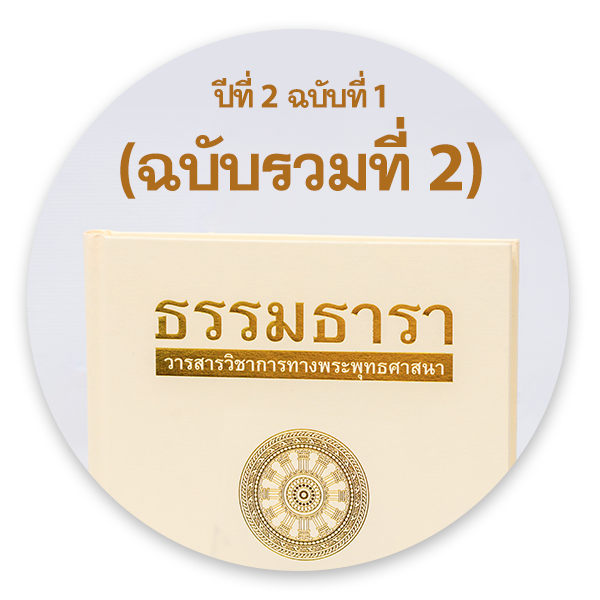The Conventional and Canonical Language in Nāgārjuna's Mūlamadhyamakakārikā
Main Article Content
Abstract
Nāgārjuna is the most well-known philosopher within the Mahāyāna Buddhist tradition. His epoch-making work, widely studied by both Eastern and Western scholars, is a Sanskrit text called Mūlamadhyamakakārikā : ‘Fundamental Verses on the Middle Way’. This text deals with several significant Buddha’s doctrines, most notably Śūnyatā and Pratītyasamutpāda, in a terse manner which is quite difficult to understand. Considering the form and the aim of the text, it is obvious that the text is for the intellectual elite within the montastic tradition of Indian Buddhism, in particular monks who have to debate profound philosophical topics with different opponents, both Buddhists and Hindus. Most of chapters of the text focus on ‘canonical language ’, the understanding of which requires profound knowledge and insight, but when considering Nāgārjuna’s ‘true aim’, it seems that he would like all human beings to discard all theories which are in the form of ‘canonical language’ and instead use ‘worldly or conventional language’ which was alternatively employed in public by the Buddha in accordance with persons, occasions and places.
The paper is a humble attempt to analyze Nāgārjuna’s Mūlamadhyamakakārikā with a special emphasis on ‘conventional and canonical language ’ or ‘Pha Sa Khon Pha Sa Tham’ in Thai language, a concept which monk Buddhadasa, the Thai eminent Buddhist scholar, first used and popularized. Other scholars’ concepts and theories, especially Thai scholars’, will be utilized in order to form a new idea of the past which can be applied
to the contemporary practice of Buddhism.
Article Details
ลิขสิทธิ์ สำนักการศึกษา วัดพระธรรมกาย
References
สมบัติ มั่งมีสุขศิริ. 2559. การศึกษาวิเคราะห์คัมภีร์มูลมัธยมการิกาของพระนาคารชุน. เอกสารอัดสำเนา. กรุงเทพฯ: ภาควิชาภาษาตะวันออก คณะโบราณคดี มหาวิทยาลัยศิลปากร.
สมภาร พรมทา. 2540. พุทธศาสนามหายาน นิกายหลัก. กรุงเทพฯ: สำนักพิมพ์แห่งจุฬาลงกรณ์มหาวิทยาลัย.
สุมาลี มหณรงค์ชัย. 2550. มหายาน ภาษาคน ภาษาธรรม. กรุงเทพฯ: สำนักพิมพ์อัมรินทร์.
Bapat, P.V. 1997. 2500 Years of Buddhism. 6th ed. New Delhi: Publication Division, Ministry of Information and Broadcasting, Government of India.
Kalupahana, David J. 1999. Mūlamadhyamakakārikā of Nāgaārjuna. Delhi: Motilal Banarsidass.
Kubo, Tsugunari, and Akira, Yuyama. 2007. The Lotus Sutra (Taishō Volume 9, Number 262), Translated from the Chinese of Kumārajīva. BKD English Tripiṭaka 13-1. Berkeley: Numata Center for Buddhist Translation and Research.
Porter, Karl H., ed. 1999. Encyclopedia of Indian Philosophy: Buddhist Philosophy from 100 to 350 A.D. Volume VIII. Delhi: Motilal Banarsidass.
Zangmo, Tashi and Chime, Dechen, trans. 1997. Dharmasaṃgrahaḥ (Excellent Collection of Doctrine) of Nāgārjuna: Bibliotheca Indo-Tibetica Series – XXVII. Varanasi : Central Institute of Higher Tibetan Studies.
พุทธทาสภิกขุ. 2556. ภาษาคน ภาษาธรรม. เข้าถึงเมื่อวันที่ 2 เมษายน 2559, https://www. youtube.com/watch?v= jPg0kib7qBY.
สมภาร พรมทา. 2554. Philosophy and Language. Chapter VI pp. 75-79. เข้าถึงเมื่อวันที่ 25 มีนาคม 2559, http://www.stc.arts.chula.ac.th/wisdommag.


